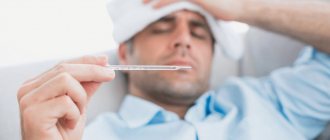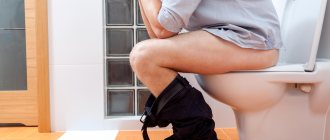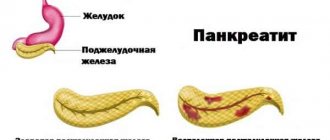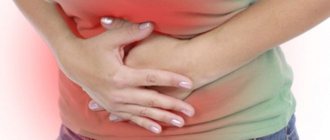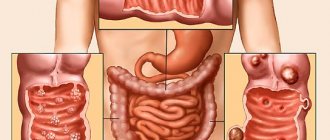Two diseases, dysbiosis and thrush, are caused by one microorganism - the Candida fungus. Their development is one of the first signs of a weakening of the human immune system and the occurrence of disturbances in the functioning of the hormonal system. Just as a violation of the intestinal microflora can cause candidal vaginitis, untreated thrush can spread to the intestines. You can get rid of dysbiosis by undergoing antifungal treatment and following a diet.
What are the similarities in etiology?
The intestinal microflora contains several hundred types of microorganisms, including E. coli, Candida fungus, and protozoan microorganisms.
The body of every person in the first minutes of life is inhabited by billions of microorganisms. They live, reproduce, and secrete the products of their vital activity—metabolites. They are called opportunistic microorganisms. Their role in the human body is to prevent pathogenic microbes from developing. The growth of opportunistic microorganisms themselves is limited by specific cells of the immune system.
The conditions for the development of the fungus and its transformation into a pathogenic microorganism are created by:
- diseases of the endocrine system;
- excess sweet products in the diet,
- taking hormonal contraceptives;
- weakening of the immune system.
Candidiasis dysbacteriosis
Active growth of the fungus destroys beneficial microflora.
The meaning of the word “dysbacteriosis” can be interpreted as an imbalance of microflora, and the word “candidiasis” says that this disorder was caused by the Candida fungus. Thus, this disease is a pathogenic predominance of yeast in the intestinal microflora. The presence of curdled formations in the stool helps to distinguish the causative agent of the disease from other pathogens. The fungus can fill the intestinal space, constantly multiplying (this is not an invasive form of the disease). The more severe form of the lesion is germination into the intestinal epithelium and further penetration into the bloodstream, invasion of other human organs (invasive form). It is very important that the invasive form will never occur in a healthy person.
Dysbacteriosis as a cause of vaginal thrush
If there is an existing lesion of intestinal candidiasis, infection of the vaginal mucosa of women is not difficult; it is important to carry out timely treatment under the supervision of a doctor. In addition, normally the vaginal microflora may contain small amounts of fungus. The disease begins to progress with intestinal candidiasis in 2 cases.
- A fungal infection penetrates from the intestines into the vagina.
- The body's fight against dysbacteriosis caused a weakening of local immunity and vaginal candidiasis developed.
Can candidiasis be caused by intestinal dysbiosis?
Two diseases, dysbiosis and thrush, are caused by one microorganism - the Candida fungus. Their development is one of the first signs of a weakening of the human immune system and the occurrence of disturbances in the functioning of the hormonal system. Just as a violation of the intestinal microflora can cause candidal vaginitis, untreated thrush can spread to the intestines. You can get rid of dysbiosis by undergoing antifungal treatment and following a diet.
The intestinal microflora contains several hundred types of microorganisms, including E. coli, Candida fungus, and protozoan microorganisms.
The body of every person in the first minutes of life is inhabited by billions of microorganisms. They live, reproduce, and secrete the products of their vital activity—metabolites. They are called opportunistic microorganisms. Their role in the human body is to prevent pathogenic microbes from developing. The growth of opportunistic microorganisms themselves is limited by specific cells of the immune system.
The conditions for the development of the fungus and its transformation into a pathogenic microorganism are created by:
- diseases of the endocrine system;
- excess sweet products in the diet,
- taking hormonal contraceptives;
- weakening of the immune system.
Return to contents
The meaning of the word “dysbacteriosis” can be interpreted as an imbalance of microflora, and the word “candidiasis” says that this disorder was caused by the Candida fungus. Thus, this disease is a pathogenic predominance of yeast in the intestinal microflora. The presence of curdled formations in the stool helps to distinguish the causative agent of the disease from other pathogens. The fungus can fill the intestinal space, constantly multiplying (this is not an invasive form of the disease). The more severe form of the lesion is germination into the intestinal epithelium and further penetration into the bloodstream, invasion of other human organs (invasive form). It is very important that the invasive form will never occur in a healthy person.
If there is an existing lesion of intestinal candidiasis, infection of the vaginal mucosa of women is not difficult; it is important to carry out timely treatment under the supervision of a doctor. In addition, normally the vaginal microflora may contain small amounts of fungus. The disease begins to progress with intestinal candidiasis in 2 cases.
- A fungal infection penetrates from the intestines into the vagina.
- The body's fight against dysbacteriosis caused a weakening of local immunity and vaginal candidiasis developed.
Return to contents
The reasons for the development of dysbiosis are that:
- a favorable environment is created for the development of yeast fungus (acidity pH 5.8-6.5, the presence of a nutritious sweet environment);
- microorganisms that inhibit the growth of the fungus die.
Abuse of sweets creates a favorable environment for the proliferation of pathogenic microorganisms.
Diabetes mellitus and excess sweet foods increase the amount of nutrient medium for fungus. It feeds and, accordingly, becomes stronger, oppressing other representatives of the microflora. Lactobacilli produce lactic acid, which is beneficial for the life of the fungus (therefore, you should use probiotics containing lactobacilli only after antifungal therapy). Taking antibiotics destroys, along with pathogenic microbes, the “good” bacteria that control the growth of the fungus. And the main reason is that the immune system does not produce enough cells and antibodies that can reduce the number of yeast fungi.
The symptoms of thrush are familiar to many women: itching, burning, irritation of the mucous membranes. Similar symptoms are caused by fungal toxins that act on epithelial cells. A discharge appears that has a sour smell, similar to curd mass. They can be distinguished by eye from normal discharge. And smear analysis will reveal mycelium threads. Swelling of the mucous membranes and irritation causes discomfort and pain during sexual intercourse. Men suffering from candidiasis complain of itching, a white coating on the head of the genital organ, and traces of erosion are visible.
Symptoms of intestinal candidiasis are shown in the table:
Based on materials from etogribok.ru
Thanks to widespread advertising of probiotics, it has become generally known that the intestines are populated by so-called beneficial bacteria that make up its microflora. They are responsible not only for digesting food, but also for maintaining immunity at a decent level, and for suppressing the growth of opportunistic microorganisms. Therefore, when a disturbance in the intestinal microflora occurs, the consequences can be more serious than indigestion.
Many doctors tend to attribute the occurrence of a disease such as thrush (candidiasis) to dysbacteriosis. Is there any reason for this? Are dysbiosis and thrush interrelated diseases?
Sometimes disruption of the intestinal microflora and the development of candidiasis begin simultaneously. Such synchronicity suggests common causes. And it’s not in vain that dysbacteriosis and candidiasis occur when opportunistic microorganisms begin to multiply vigorously, only in the first case this process occurs in the intestines, and in the second it is not necessary. It is not uncommon for thrush to develop in the mouth, and in women, thrush of the genital organs is most common.
So what provokes the uncontrolled growth of opportunistic microorganisms? The most common factor is taking antibiotics.
Antibiotics are serious soldiers who destroy not only the enemy, but also civilians, which is why the intestinal mucosa after a course of antibiotic therapy looks like a scorched wasteland.
This is why most doctors prescribe, in parallel with antibiotics, various drugs that restore normal microflora (not just the intestines).
Another serious risk factor is reduced immunity - having successfully recovered from an infectious disease, you can get a continuation in the form of dysbacteriosis or fungal infection. And all because the body was tired during the struggle, and the opportunistic microflora won.
In women, candidiasis often occurs as a result of a violation of the intestinal microflora. This is explained by the fact that a woman’s genital organs are located close to the anus, and there is a constant risk of introducing bacteria from the intestines into the vagina, where there is a favorable environment for their reproduction.
Another reason for problems with microflora in women is pregnancy. This is a great stress for the body, accompanied by hormonal changes, which means that opportunistic microorganisms have the opportunity to become pathogenic, significantly increasing their number.
Given the similar nature of the two diseases in question, treatment will have the same goal:
- destroy harmful microorganisms;
- populate the mucous membranes with protective bacteria.
However, the ways to achieve the goal will be different:
- in the case of thrush, you must first get rid of the overgrown Candida fungus;
- in case of dysbacteriosis – from harmful microbes.
Treatment of both diseases should follow a certain scheme.
Elimination of pathogenic microflora, for which the following are used for candidiasis:
- antifungal ointments (Clotrimazole, Miconazole, Candide);
- suppositories (Pimafucin, Nystatin);
- oral medications (Fluconazole, Flucostat).
And for dysbacteriosis - antimicrobial drugs (Enterofuril, etc.).
You need to follow a diet that excludes:
Preference should be given to boiled, stewed and steamed dishes. It is necessary to add fermented milk products to the menu (especially natural live yoghurts and kefir).
It is necessary to repopulate the affected mucous membranes with beneficial microflora, which can be partially achieved with natural fermented milk products, but medications (Linex, Acipol, Bifidumbacterin, etc.) can cope with this faster and more effectively.
It would also be useful to take vitamins and microelements to raise immunity to the required level and prevent relapses of the disease. These are vitamins A, C, E, group B, iodine, magnesium, selenium, zinc and others. It will be better if helping the body is not limited to one or two vitamins, but provides it with everything it needs. For this purpose, special complexes are suitable, a wide selection of which is available in every pharmacy.
After completing treatment, it will be useful to take control tests. For thrush, this will be a vaginal smear (taken from a gynecologist), for dysbiosis - feces (a therapist or gastroenterologist will send and see the results). If you don't make sure the problem is fixed, you may find that your symptoms return within a few days. Then the treatment will have to be repeated, and this is another test for the body.
Even if you have a weakened immune system, you can prevent problems with microflora from occurring. Natural fresh fermented milk products, especially those containing live bacteria, are a wonderful help in the prevention of dysbiosis and thrush. We are talking about biokefir and bioyogurt. And among store brands you can find really healthy and natural fermented milk products, but those prepared at home will be even healthier.
Almost any pharmacy can offer a choice of two or three starter cultures with which you can prepare homemade dairy products:
You can also use milk mushroom.
Another important point of prevention for women is reasonable hygiene. You should not be too zealous with washing, as this disrupts the natural microflora of the mucous membranes. And no antibacterial soap. The direction also matters: washing must be done from front to back, otherwise the act of cleanliness will turn into an act of relocation of intestinal bacteria.
During menstruation, it is necessary to promptly change hygiene products, especially when it comes to tampons. Keeping a tampon inside the body for too long (more than 5 hours) helps dry out the vaginal mucosa, making it unable to fight harmful microorganisms.
In order not to wash out the beneficial microflora, you should not overuse douching and enemas, and if you are going to undergo a course of antibiotic therapy, you should definitely stock up on medications at the pharmacy that restore the intestinal microflora.
Many women who have had thrush complain of multiple relapses of the disease. Sometimes you have to be treated three, four, five times in a row before you manage to forget about this illness. In some cases, it was possible to get rid of the disease only after intestinal dysbiosis was treated. This indicates an irrefutable connection between dysbiosis and candidiasis.
There is evidence that dysbiosis (and with it thrush) can haunt the entire life of those who have serious diseases of the gastrointestinal tract. In this case, it is necessary to carefully follow the diet and conscientiously take the medications prescribed by the doctor.
Restoring microflora is not as simple as it might seem - it is a long process that requires constant attention and compliance with the necessary conditions. Proper nutrition, good hygiene, lack of stress and timely treatment of all infections are the main components of health that will save the body from attack by harmful microorganisms.
Based on materials from www.omolochnice.ru
More and more often on TV you can see advertisements for probiotics, which help maintain normal intestinal microflora.
As you know, the cavity of this organ is populated by beneficial bacteria, which are responsible for processing incoming food, maintaining immunity at the proper level and suppressing opportunistic microorganisms.
It is for this reason that when the destruction of the normal microflora of the intestinal cavity develops, not only serious disruptions in digestion can occur, but also pathologies such as thrush and dysbiosis.
Quite often, experts attribute the fact of the manifestation of candidiasis to dysbiosis. But are their theories conditioned?
Are thrush and dysbiosis interrelated pathologies? All this will be discussed below in the article.
Thrush or candidiasis in the intestines first of all makes itself felt by severe pain.
In addition, you should pay attention to the following symptoms:
- constant bloating;
- feeling of heaviness in the stomach or epigastric region;
- complaints that after eating the intestines begin to spasm;
- diarrhea;
- body temperature rises to 37.5 degrees;
- loss of appetite;
- impurities of pus and blood appear in the feces;
- in the anal and fecal areas there may be a cheesy discharge that smells unpleasant;
- even after bowel movement, there is no feeling of relief;
- false urge to defecate;
- the skin becomes covered with a rash;
- pain during defecation.
In addition, intestinal dysbiosis is manifested by fatigue, acne, insomnia, urticaria, and dermatitis.
If these signs of pathology are detected, you should seek help from a gastroenterologist.
If you do not do this on time, there is a risk that intestinal dysbiosis will begin to make itself felt more and more often, as symptoms increase as Candida fungi spread.
All this leads to the spread of the virus to different parts of the body, affecting candidiasis dysbiosis of the oral cavity and genitourinary organs.
In addition, an exacerbation of diseases associated with the gastrointestinal tract begins. When dysbiosis and thrush appear on the genitals of women, the following symptoms of pathology will be noticeable:
- vaginal discharge in the form of a cheesy mass. They will also remain on your underwear. Their smell is very unpleasant, many note that it resembles rotten fish;
- there is severe itching of the genitals, which gradually turns into a burning sensation;
- pain during sexual intercourse and urination;
- disruption of the menstrual cycle or complete absence of menstrual periods;
- development of infertility.
In men, the symptoms have several differences:
- itching and burning sensation in the area of the penis and scrotum;
- dysfunction of urination;
- discharge from the genitals, similar to cottage cheese.
The clinical picture when the intestinal area is affected by Candida will be pronounced, and therefore you should not hesitate and begin treatment.
But it is important that the patient does not take on this point on his own, but seeks help from a qualified doctor.
If the oral cavity is affected by Candida fungus, the following symptoms are present:
- inflammation of the mucous membrane;
- pain while eating;
- white coating on the tongue.
Sometimes, disruption of the normal environment in the intestines and the development of thrush can begin simultaneously. This suggests that the causes of the pathologies are similar.
It is not without reason that candidiasis and bacteriosis begin to appear when opportunistic microorganisms multiply.
The most important reason for the development of pathologies is a course of antibiotics, which burn out not only harmful bacteria from the intestines, but also beneficial ones. It is for this reason that it is customary to prescribe drugs aimed at maintaining microflora for use with antibiotics.
Another reason is decreased immunity. When a person tries to cure an infectious disease, he may contract a fungal infection or dysbacteriosis.
The thing is that the body is tired of the confrontation, and therefore the opportunistic microflora took advantage of this fact and took a dominant position.
It should be noted that stress in the form of fertilization of the female body can also provoke this pathology.
There is a complete restructuring of the hormonal level, and therefore opportunistic microorganisms can take the position of pathogenic ones, increasing their number.
If adequate treatment is not carried out, serious complications of dysbiosis cannot be avoided.
The most terrible things in this case will be the development of ulcers breaking through into nearby tissues, as well as the entry of their contents into the cavity of the organ that has encountered damage.
To make an accurate diagnosis, the doctor acts simultaneously in several directions. First of all, the curdled discharge is sent to the laboratory for examination.
This is the accumulation of the pathogen. The study is carried out using microscopic and bacteriological methods. Sometimes doctors use PCR or serology.
The specialist is faced with the task of understanding what the true reason is that triggered the development of an opportunistic infection.
When affected by intestinal fungus, it is very important to normalize nutrition. It is for this reason that diet therapy is one of the main methods of treatment.
From the diet of a patient with dysbacteriosis or thrush, it is worth excluding baked goods with yeast, sweets and sugar, honey, potatoes, citrus fruits, spices, and semi-finished products.
It is important not to overeat, and to establish a split-meal option that involves eating 5 times a day.
Low-fat dairy products with low sugar content, boiled meat or cooked in a double boiler will have a positive effect on the healing process.
It is better if it is turkey, chicken, beef. It is also recommended to eat zucchini, pumpkin, cauliflower, lettuce, dill, spinach, parsley, onion, garlic, and drink carrot juice with vegetable oil.
You should definitely eat green apples, as they are indispensable in the fight against dysbiosis.
If the patient follows these nutritional principles, he will soon set a course for recovery.
Treatment must be comprehensive. If the symptoms have disappeared, this does not mean that you should stop taking the medications without your doctor’s permission.
The specialist must prescribe a clear scheme for using therapy after diagnosing the patient’s body.
Treatment has 2 goals: to remove microorganisms that attack the microflora of the organ and to populate the area with bacteria with protective functions.
If this is dysbacteriosis, then it is necessary to exclude harmful microbes, and in case of thrush - Candida fungus.
For prevention purposes, it is worth consuming fresh fermented milk products with natural fresh bacteria.
These are bio-yogurt and bio-kefir. It is best to make them at home using sourdough or milk mushroom.
It is important to observe hygiene measures, but to use moderation in everything. There is no need to overdo it with washing so that the natural microflora of the mucous membrane is not disturbed.
Based on materials from jeludokbolit.ru
What causes dysbiosis?
The reasons for the development of dysbiosis are that:
- a favorable environment is created for the development of yeast fungus (acidity pH 5.8-6.5, the presence of a nutritious sweet environment);
- microorganisms that inhibit the growth of the fungus die.
Abuse of sweets creates a favorable environment for the proliferation of pathogenic microorganisms.
Diabetes mellitus and excess sweet foods increase the amount of nutrient medium for fungus. It feeds and, accordingly, becomes stronger, oppressing other representatives of the microflora. Lactobacilli produce lactic acid, which is beneficial for the life of the fungus (therefore, you should use probiotics containing lactobacilli only after antifungal therapy). Taking antibiotics destroys, along with pathogenic microbes, the “good” bacteria that control the growth of the fungus. And the main reason is that the immune system does not produce enough cells and antibodies that can reduce the number of yeast fungi.
Dysbacteriosis in women
Dysbacteriosis means a violation of the natural balance of microflora. The intestines are inhabited by beneficial bacteria, as well as opportunistic microflora. The number of the latter group of bacteria is strictly controlled by the immune system.
If for some reason our body’s defense system weakens, these microorganisms become active, leading to the development of the disease. As a result, the number of beneficial bacteria decreases, while the number of opportunistic pathogens increases sharply.
Normal intestinal microflora plays an irreplaceable role in the functioning of our body. First of all, it is worth highlighting the protective function. Bacteria do not allow foreign microorganisms that can cause disease to settle in the intestines. Bifidobacteria secrete special substances that inhibit the development of foreign microbes.
But that’s not all, beneficial bacteria stimulate the immune system, remove toxic substances, participate in digestion processes, and suppress allergic reactions. Moreover, bifidobacteria engulf cancer cell precursors, exerting an anticarcinogenic effect.
But sometimes emotional overload and prolonged stress can provoke an imbalance in the intestinal microflora. Dysbacteriosis in women brings a lot of inconvenience and interferes with enjoying life. The pathological process causes side symptoms that negatively affect the condition of vital organs and systems.
With dysbacteriosis, opportunistic microorganisms get out of control
Symptoms of candidiasis
The symptoms of thrush are familiar to many women: itching, burning, irritation of the mucous membranes. Similar symptoms are caused by fungal toxins that act on epithelial cells. A discharge appears that has a sour smell, similar to curd mass. They can be distinguished by eye from normal discharge. And smear analysis will reveal mycelium threads. Swelling of the mucous membranes and irritation causes discomfort and pain during sexual intercourse. Men suffering from candidiasis complain of itching, a white coating on the head of the genital organ, and traces of erosion are visible.
Symptoms of intestinal candidiasis are shown in the table:
| Form | Symptoms |
| Invasive diffuse |
|
| Invasive focal |
|
| Non-invasive |
|
Why does thrush occur?
The prevalence of thrush is increasing year by year.
Today it occupies 45% of the structure of all infections that affect the female genital organs. Over the course of their lives, more than 75% of Russian women get it, and more than half of them “get” thrush again. According to Natalya Trifonova, a gynecologist at City Clinical Hospital No. 40, the causes of vulvovaginitis (inflammatory diseases of the female genital organs) can be different. Even wearing underwear that is too tight, which does not provide air flow to this area.
And also hypovitaminosis or allergic reactions. Or, for example, violating the rules for using tampons. However, the direct culprit of thrush is a fungus of the genus Candida. Normally, they are present in every fifth woman, but they begin to multiply rapidly when a disorder occurs in the body.
Therapeutic treatment of dysbiosis and thrush
Full recovery is possible with comprehensive treatment.
Thrush and intestinal candidal dysbiosis are respectively treated by a gynecologist/urologist and a gastroenterologist. The treatment regimen is similar and is aimed at:
- Carrying out antifungal therapy - prescribing antifungal drugs of systemic and local action:
- For the treatment of vaginal candidiasis, suppositories, natamycin-based vaginal tablets - "Pimafucin", "Terzhinan" or oral tablets - "Fluconazole" are prescribed.
- Nystatin tablets are more effective for the treatment of intestinal candidiasis.
- At the end of antifungal therapy, the microflora is populated with “beneficial” microorganisms. It is recommended to take probiotics containing bifidobacteria and symbiotic complexes (Bifiform, Acipol, Bifidumbacterin suppositories).
- Immunomodulation is the use of drugs that improve the functioning of the human immune system.
The most effective way to combat dysbiosis is treatment with medications and diet.
The diet limits the consumption of simple carbohydrates and sweet fruits (including watermelon, bananas) and dried fruits, alcohol, and baked goods. At the same time, the number of vegetable dishes in the diet increases, the consumption of lean meats and fish (not fried), as well as natural yoghurts is allowed.
How to treat thrush at home
It must be remembered that any disease must be treated by a doctor. Self-administration of medications can be hazardous to health. Thrush after antibiotics is not uncommon. If you are sure that this is not another disease, then you can buy medications at the pharmacy that do not require prescriptions. Such drugs as Clotrimazole, Pimafucin, Livarol and Polygynax are quite effective in the treatment of candidiasis. Products can be purchased in the form of creams or suppositories.
If thrush progresses after antibiotics, then tablets with an antifungal effect should be added to the listed drugs. At the same time, it is recommended to consume more fermented milk products. Chronic candidiasis or its severe form should be treated strictly under the supervision of a doctor.
How are microflora disorders treated?
Given the similar nature of the two diseases in question, treatment will have the same goal:
- destroy harmful microorganisms;
- populate the mucous membranes with protective bacteria.
However, the ways to achieve the goal will be different:
- in the case of thrush, you must first get rid of the overgrown Candida fungus;
- in case of dysbacteriosis – from harmful microbes.
Treatment of both diseases should follow a certain scheme.
Elimination of pathogenic microflora, for which the following are used for candidiasis:
- antifungal ointments (Clotrimazole, Miconazole, Candide);
- suppositories (Pimafucin, Nystatin);
- oral medications (Fluconazole, Flucostat).
And for dysbacteriosis - antimicrobial drugs (Enterofuril, etc.).
[ads-pc-3] [ads-mob-3]
Nutrition tips
You need to follow a diet that excludes:
- sweets;
- alcohol;
- baking;
- pickles;
- canned food;
- spicy;
- roast;
- fatty.
Preference should be given to boiled, stewed and steamed dishes. It is necessary to add fermented milk products to the menu (especially natural live yoghurts and kefir).
It is necessary to repopulate the affected mucous membranes with beneficial microflora, which can be partially achieved with natural fermented milk products, but medications (Linex, Acipol, Bifidumbacterin, etc.) can cope with this faster and more effectively.
It would also be useful to take vitamins and microelements to raise immunity to the required level and prevent relapses of the disease. These are vitamins A, C, E, group B, iodine, magnesium, selenium, zinc and others. It will be better if helping the body is not limited to one or two vitamins, but provides it with everything it needs. For this purpose, special complexes are suitable, a wide selection of which is available in every pharmacy.
After completing treatment, it will be useful to take control tests. For thrush, this will be a vaginal smear (taken from a gynecologist), for dysbiosis - feces (a therapist or gastroenterologist will send and see the results). If you don't make sure the problem is fixed, you may find that your symptoms return within a few days. Then the treatment will have to be repeated, and this is another test for the body.
[ads-pc-4] [ads-mob-4]
How to treat thrush in children?
Thrush in a child after antibiotics occurs in the genital area. The disease is accompanied by disruption of the gastrointestinal tract. Treatment is aimed at destroying the Candida fungus and restoring the natural microflora. Basically, when treating thrush, doctors prescribe drugs for children such as Linex, Bifidumbacterin and Bifiform.
For local therapy, Candide, Nystatin and Pimafucin are used, as well as 2% solutions of tannin and soda. Be sure to follow a diet. Sweet, spicy and salty foods are excluded from the child’s diet. The pediatrician usually prepares an individual diet for each patient. Medicines are prescribed based on the severe symptoms of thrush and the age of the child. The duration of taking the drugs is determined by the doctor.
Thrush is much less common in men, but is no less dangerous. The disease can be caused by damage to the mucous membrane, through which a pustular infection enters the body.

